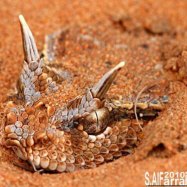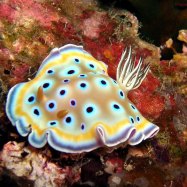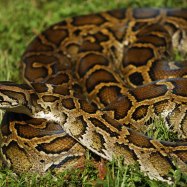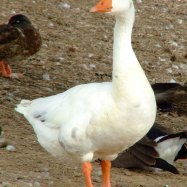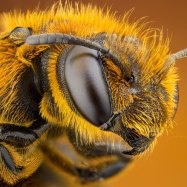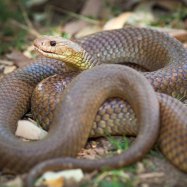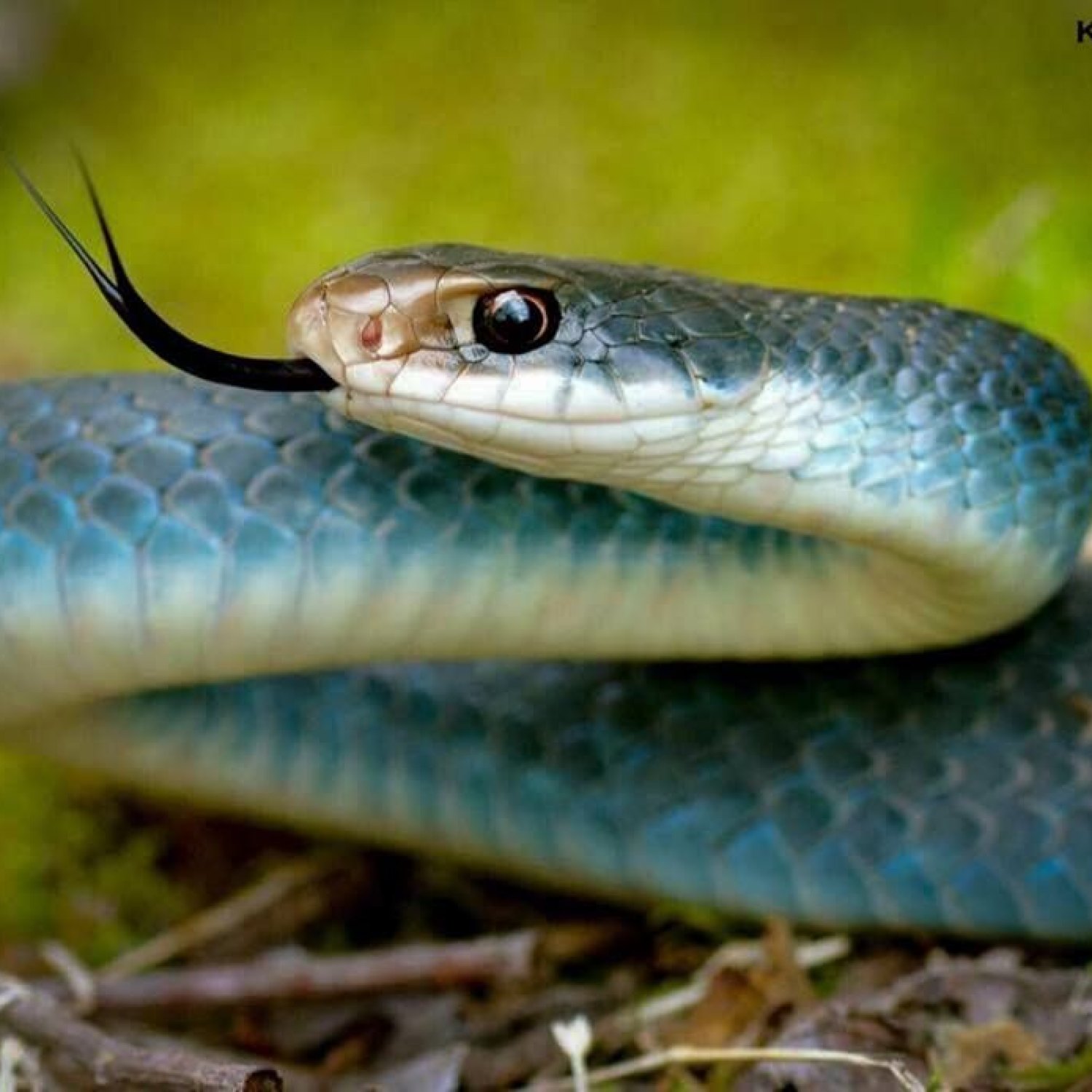
Blue Racer
2 to 4 feet
The Blue Racer, a common name for the slender, long-bodied snake known as the Colubridae family, can be found in the Midwest and Great Plains regions of the US. With a length of 2 to 4 feet, this speedy reptile is a sight to behold. Keep an eye out for this exciting creature on your next hike!
Animal Details Summary:
Common Name: Blue Racer
Kingdom: Animalia
Habitat: Grasslands, prairies, open forests
The Blue Racer: Sleek, Swift and Serpentine
When one thinks of a snake, they may envision a slithering and menacing predator. However, the Blue Racer, scientifically known as Coluber constrictor foxi, is much more than meets the eye. This beautiful and fascinating reptile, found in the grasslands and prairies of North America, is a sight to behold. In this article, we will explore the unique characteristics of this species, its habitat, eating habits, and its importance in the ecosystem Blue Racer.The Basics: Taxonomy and Appearance
The Blue Racer belongs to the Animalia kingdom, the highest taxonomic rank for living organisms. Within the kingdom, it belongs to the Phylum Chordata, meaning it has a spinal column. It is part of the class Reptilia, and the order Squamata, which includes snakes and lizards. It is a member of the Colubridae family, which is the largest family of snakes with over 1700 species.At first glance, the Blue Racer may not look like anything special. Its overall coloration is a gray or blue-gray, with a white or yellow underside. However, when in motion, this snake is truly stunning. Its scales seem to shimmer as it moves, giving the appearance of a racing ribbon, hence its name.
The Blue Racer's body shape is quite distinctive, with a long and slender frame Bluefish. Its average length is between 2 to 4 feet, making it one of the longer species of snakes. Its head is elongated and narrow, with a pronounced snout. Its eyes are large and round, providing it with excellent vision.
Home Sweet Home: Habitat and Distribution
The Blue Racer is native to the United States, particularly in the Midwest and Great Plains regions. It can also be found in parts of Canada and Mexico. Its preferred habitat is grasslands, prairies, and open forests, where it can find ample cover and space to hunt.This snake is an excellent climber and can also be found sunbathing on trees or rocks. It is a diurnal species, meaning it is most active during the day, making it easier to spot in the wild.
Food for Thought: Feeding Habits
As carnivores, Blue Racers have a diet primarily consisting of small mammals and birds. They are skilled hunters and are known for their swift movements when tracking prey.One of the notable characteristics of this snake is its constricting ability, which is how it got its scientific name, Coluber constrictor. This means that instead of injecting venom, it wraps itself around its prey, cutting off its blood circulation. Once the prey is immobilized, it is swallowed whole.
This species also has another unique way of hunting. It has observed jumping up into or near bird's nests to consume eggs or young hatchlings. This behavior is known as eruptive feeding and is not commonly seen in other snake species.
The Importance of the Blue Racer
While some may view snakes as a nuisance or threat, the Blue Racer plays a crucial role in the ecosystem. As an apex predator, it helps to control the population of rodents and other small mammals, which can cause damage to agricultural crops.Additionally, this species is a valuable source of food for other animals, such as birds of prey and larger snakes. Thus, its presence helps to maintain a balanced and healthy ecosystem.
Threats and Conservation
Unfortunately, the Blue Racer is facing several threats in the wild. Deforestation, habitat destruction, and fragmentation have significantly reduced its population, making it a species of concern in some areas.Furthermore, illegal collection for the pet trade has also impacted its numbers in the wild. This species may be desirable as a pet due to its striking appearance, but it is not recommended to keep as a pet as it requires specialized care and can be potentially dangerous to handle.
To protect this species, it is crucial to preserve and restore its natural habitat and raise awareness about its importance in the ecosystem. Additionally, laws and regulations must be implemented to prevent the illegal trade and collection of this species.
In Conclusion
The Blue Racer may not be the most well-known or beloved species, but it is undoubtedly a fascinating one. From its stunning appearance to its unique hunting habits, it is an essential part of our natural world.As we continue to learn more about this species and the vital role it plays, it is crucial to protect and conserve its habitat and population. While snakes may not be everyone's cup of tea, they are a crucial part of our ecosystem and deserve our respect and appreciation.

Blue Racer
Animal Details Blue Racer - Scientific Name: Coluber constrictor foxi
- Category: Animals B
- Scientific Name: Coluber constrictor foxi
- Common Name: Blue Racer
- Kingdom: Animalia
- Phylum: Chordata
- Class: Reptilia
- Order: Squamata
- Family: Colubridae
- Habitat: Grasslands, prairies, open forests
- Feeding Method: Carnivorous
- Geographical Distribution: North America
- Country of Origin: United States
- Location: Midwest and Great Plains regions
- Animal Coloration: Gray or blue-gray, with a white or yellow underside
- Body Shape: Slender and elongated
- Length: 2 to 4 feet
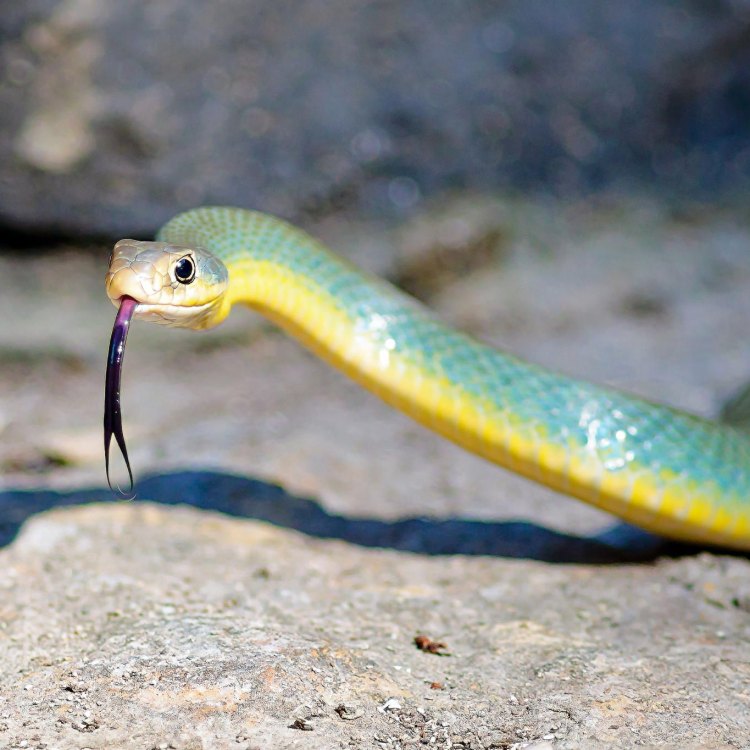
Blue Racer
- Adult Size: Medium-sized snake
- Average Lifespan: 8 to 12 years
- Reproduction: Eggs
- Reproductive Behavior: Mating occurs in the spring
- Sound or Call: Does not make sound or call
- Migration Pattern: Non-migratory
- Social Groups: Solitary
- Behavior: Aggressive and fast-moving
- Threats: Habitat loss and fragmentation, road mortality
- Conservation Status: Least Concern
- Impact on Ecosystem: Blue Racers help control rodent populations
- Human Use: No significant human use
- Distinctive Features: Bright blue coloring with a racing stripe down the back
- Interesting Facts: Blue Racers are known for their speed and agility
- Predator: Various bird species, mammals, and other snakes
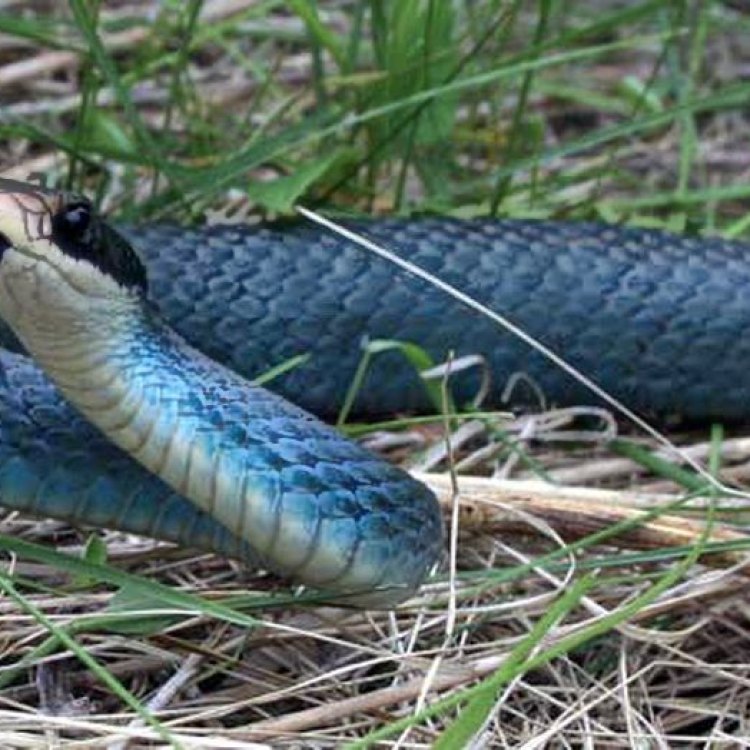
Coluber constrictor foxi
The Fascinating World of the Blue Racer Snake
Deep in the forests and grasslands of North America, a sleek and powerful predator roams; the Blue Racer snake. With its striking bright blue color and lightning-fast movements, this species has captivated the hearts and minds of nature enthusiasts for decades. While often overshadowed by its larger and more well-known snake cousins, the Blue Racer has its own unique features, behaviors, and role in the ecosystem that make it one of the most fascinating animals in the natural world. In this article, we will explore the biology, behaviors, and importance of the Blue Racer snake, and discover why it is a truly remarkable creature PeaceOfAnimals.Com.An Impressive Adult Size
The Blue Racer, also known as Coluber constrictor foxii, is classified as a medium-sized snake. On average, its total length ranges between 3 to 5 feet, with the record being just over 6 feet. This size makes it significantly smaller than other North American snakes such as the Eastern Diamondback Rattlesnake and the Black Mamba. However, do not be fooled by its relatively small stature; the Blue Racer is a formidable hunter and holds its own in the wild.
An Above-Average Lifespan
When compared to other snake species, the Blue Racer has a relatively long lifespan, averaging between 8 to 12 years. This is a significant contrast to other mammals and reptiles that have much shorter lifespans, often due to being preyed upon. The Blue Racer’s impressive lifespan is a reflection of its adaptability and success in its environment.
Reproduction and Mating Behavior
Like many other reptiles, Blue Racers reproduce through laying eggs. In early spring, male Blue Racers will begin to engage in courtship displays to woo their potential mates Bottlenose Dolphin. These displays include head bobbing and body movements, which can often appear aggressive and intimidating. However, this is all part of the mating ritual, and the female will ultimately choose a male with whom she will mate. Interestingly, Blue Racers tend to be monogamous, meaning they will often pair with the same partner for multiple breeding seasons.
A Soundless Serpent
One of the unique features of the Blue Racer is that it does not make sound or call. While other snakes may hiss or rattle their tails to communicate, the Blue Racer relies on visual cues and body language to communicate with other snakes and potential prey. This is a useful adaptation for a predator that relies on stealth and surprise to catch its meals.
Non-Migratory Patterns
Unlike some bird and mammal species that migrate long distances in search of food or nesting grounds, the Blue Racer is a non-migratory species. This means that it stays in a relatively small area throughout its life, making it a true homebody. This behavior allows the Blue Racer to get to know its territory intimately, giving them a better chance of survival and successful hunting.
Solitary Hunters
Blue Racers are mainly solitary animals, with the exception of breeding season when they are paired up with a mate. This behavior is often seen in snakes, as they have to compete for resources and can become territorial. Solitary behavior also allows the Blue Racer to be more agile and elusive while hunting, making them more successful in capturing prey.
An Aggressive and Fast-Moving Predator
If you encounter a Blue Racer in the wild, the best course of action is to observe from a safe distance. This is because they are known to be aggressive and fast-moving predators when cornered or threatened. Their bright blue coloration serves as a warning to potential predators and a signal to keep their distance.
Threats to the Blue Racer Snake
As with many other animal species, the Blue Racer is facing various threats in its natural habitat. One of the most significant threats is habitat loss and fragmentation. As human populations expand and encroach on natural areas, the Blue Racer's habitat is being destroyed, making it increasingly challenging for them to survive. Road mortality is also a significant concern for Blue Racers, as they often become victims of vehicle collisions while crossing roads.
Conservation Status
Despite these threats, the Blue Racer is currently listed as Least Concern on the IUCN Red List. This means that the species is currently not in danger of extinction, although conservation efforts are always beneficial to ensure their numbers remain stable.
The Blue Racer's Role in the Ecosystem
While the Blue Racer may be seen as a nuisance by some due to its aggressive nature and intimidating appearance, it plays a vital role in the ecosystem. As predators, they help control rodent populations, which can become imbalanced and cause widespread damage if left unchecked. This makes them valuable to the health of the ecosystem and a crucial part of the food chain.
No Significant Human Use
As with many other snake species, the Blue Racer does not have any significant human use. While some cultures may hunt them for their skin or meat, this is not a widespread practice, and their population is not significantly impacted by it.
Distinctive Features and Interesting Facts
The Blue Racer's most striking feature is its bright blue coloring, which gives the species its name. This unique coloration also acts as camouflage in the blue-green forests and grasslands they inhabit. Additionally, Blue Racers have a distinctive racing stripe that runs down their back, further adding to their unique appearance.
Aside from their physical appearance, Blue Racers are also known for their speed and agility. They are one of the fastest snakes in North America, capable of reaching speeds of up to 4 miles per hour. This is an impressive feat for a creature that lacks limbs and relies on its muscles to propel itself forward.
Predators of the Blue Racer
The Blue Racer's bold coloration and swift movements may make it seem invincible, but it still has predators in the wild. Various bird species, mammals, and even other snakes can pose a threat to the Blue Racer. They use their quick and agile movements to evade these predators and avoid becoming a meal.
In Conclusion
The Blue Racer snake may be small in size, but it is a powerful and impressive predator that plays a crucial role in its ecosystem. Its bright blue coloration, speedy movements, and solitary nature make it a unique and fascinating species. While facing some threats, their current conservation status is stable, and they continue to coexist with other wildlife in their natural habitats. Next time you are out exploring nature, keep an eye out for the magnificent and elusive Blue Racer, and admire its distinct features and behaviors that make it truly one of a kind.
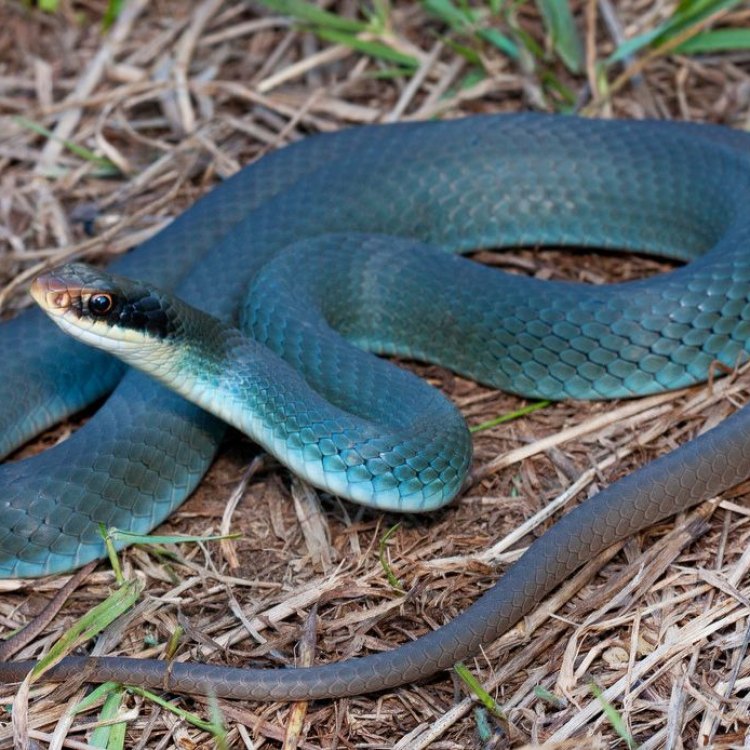
The Blue Racer: Sleek, Swift and Serpentine
Disclaimer: The content provided is for informational purposes only. We cannot guarantee the accuracy of the information on this page 100%. All information provided here may change without prior notice.


